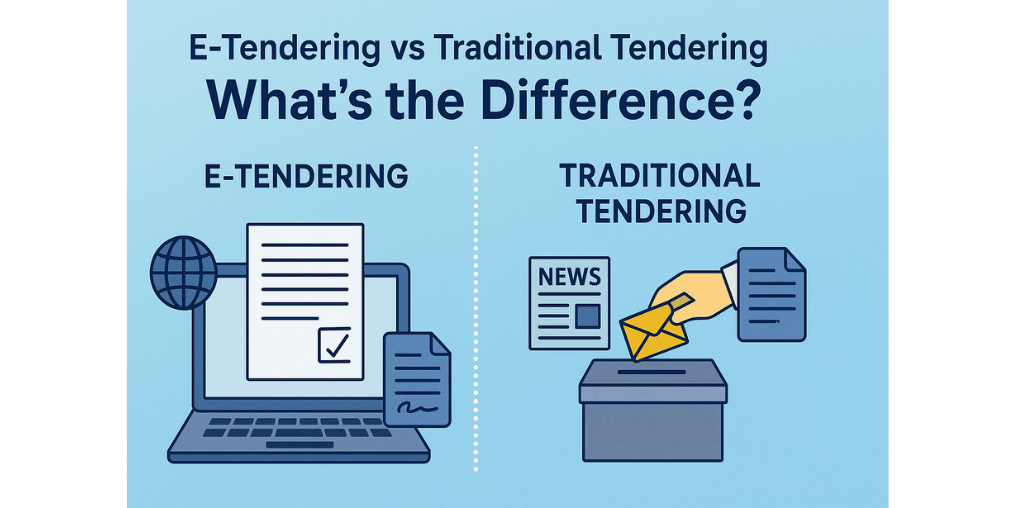E-Tendering vs Traditional Tendering: What’s the Difference?

Tendering is a critical process in procurement, enabling organizations to select suppliers or contractors for goods, services, or projects. Traditionally, tendering has been a manual, paper-based process, but with advancements in technology, e-tendering has emerged as a modern alternative. This blog explores the key differences between e-tendering and traditional tendering, highlighting their advantages, challenges, and impacts on businesses and government organizations.
What is Traditional Tendering?
Traditional tendering is the conventional method of procurement where organizations invite bids through physical documents. The process typically involves:
- Paper-Based Documentation: Tender documents, including specifications, terms, and conditions, are prepared and distributed in hard copy.
- Physical Submission: Bidders submit their proposals in sealed envelopes, often delivered by mail or in person.
- Manual Evaluation: The procuring entity manually reviews and evaluates submissions, which can be time-consuming and prone to human error.
- In-Person Communication: Clarifications or negotiations often require face-to-face meetings or written correspondence.
Advantages of Traditional Tendering
- Familiarity: Well-established and widely understood, especially in regions with limited digital infrastructure.
- Accessibility: Does not require advanced technology, making it accessible for smaller organizations or those in remote areas.
- Tangible Records: Physical documents provide a clear, tangible audit trail.
Challenges of Traditional Tendering
- Time-Consuming: Preparing, distributing, and evaluating paper-based tenders takes significant time.
- High Costs: Printing, mailing, and storing documents incur substantial costs.
- Error-Prone: Manual processes increase the risk of errors, such as lost documents or misinterpretations.
- Limited Reach: Physical tenders may exclude distant or international bidders due to logistical constraints.
What is E-Tendering?
E-tendering, or electronic tendering, leverages digital platforms to streamline the procurement process. It involves:
- Online Platforms: Tender documents are uploaded to a secure online portal, accessible to registered bidders.
- Electronic Submission: Bidders submit proposals digitally, often with e-signatures for authentication.
- Automated Evaluation: Software tools assist in evaluating bids, often using predefined criteria to ensure fairness.
- Real-Time Communication: Queries, clarifications, and updates are managed through the platform, reducing delays.
Advantages of E-Tendering
- Efficiency: Automation reduces the time required for publishing, submitting, and evaluating tenders.
- Cost Savings: Eliminates expenses related to printing, mailing, and physical storage.
- Transparency: Digital records and audit trails enhance accountability and reduce the risk of fraud.
- Global Reach: Online platforms enable participation from bidders worldwide, increasing competition.
- Data Analytics: E-tendering systems often provide insights into bidding trends, helping organizations make informed decisions.
Challenges of E-Tendering
- Digital Divide: Requires reliable internet access and technical expertise, which may exclude smaller or less tech-savvy bidders.
- Initial Setup Costs: Implementing an e-tendering system involves upfront investment in software and training.
- Security Concerns: Cybersecurity risks, such as data breaches, require robust safeguards.
- Resistance to Change: Organizations accustomed to traditional methods may resist transitioning to digital platforms.
Key Differences between E-Tendering and Traditional Tendering
| Aspect | Traditional Tendering | E-Tendering |
|---|---|---|
| Medium | Paper-based, physical documents | Digital, online platforms |
| Submission Process | Physical delivery (mail or in-person) | Electronic submission via portal |
| Speed | Slow, due to manual processes | Fast, with automation and real-time updates |
| Cost | High (printing, mailing, storage) | Low (digital processes reduce physical costs) |
| Accessibility | Limited by geography and logistics | Global, accessible to anyone with internet |
| Transparency | Prone to errors and less transparent | High transparency with digital audit trails |
| Environmental Impact | High (paper usage, transportation) | Low (paperless, eco-friendly) |
| Security | Risk of lost or tampered documents | Risk of cyberattacks, requires robust security |
Which is better?
The choice between e-tendering and traditional tendering depends on an organization’s needs, resources, and context:
- Traditional Tendering is suitable for smaller organizations or regions with limited technological infrastructure. It remains relevant where regulatory frameworks mandate physical documentation or where stakeholders prefer familiar processes.
- E-Tendering is ideal for organizations aiming to enhance efficiency, reduce costs, and promote transparency. It is particularly effective for large-scale projects or government procurement, where global participation and streamlined processes are priorities.
Many organizations adopt a hybrid approach, using traditional methods for smaller tenders and e-tendering for larger, complex projects. As digital infrastructure improves globally, e-tendering is becoming the preferred choice for its scalability and cost-effectiveness.
Real-World Impact
- Government Procurement: Many governments, such as those in the European Union and India, have adopted e-tendering platforms (e.g., EU’s TED platform, India’s GeM portal) to enhance transparency and reduce corruption.
- Private Sector: Businesses leverage e-tendering to access a broader pool of suppliers, driving competitive pricing and innovation.
- Sustainability: E-tendering aligns with environmental goals by reducing paper usage and carbon footprints associated with physical logistics.
Conclusion:
E-tendering and traditional tendering represent two distinct approaches to procurement, each with its strengths and challenges. While traditional tendering offers familiarity and accessibility, e-tendering provides efficiency, transparency, and global reach. As technology continues to evolve, e-tendering is poised to dominate, but the transition requires addressing challenges like the digital divide and cybersecurity. Organizations must weigh their priorities—whether cost, speed, or accessibility—to choose the approach that best suits their needs.
By understanding the differences between these methods, businesses and governments can make informed decisions to optimize their procurement processes in an increasingly digital world.
We at Classic Tenders Provide Online and Offline Tender Bidding Service. As a leading tender bidding company and e-procurement tender consultant, we provide online /offline tender bidding support with Whether you're bidding for local, state, or central tenders, CTPL ensures your success with full-spectrum tender bidding consultancy. From meticulous daily tender discovery powered by our AI-driven intelligence and precise bid document preparation to flawless online submission, vendor registration, strict compliance, and crucial post-bid support, our highly experienced team ensures complete accuracy, strategic bidding, and full regulatory adherence. This maximizes your success in securing high-value government contracts and public tenders across India.
 By Admin
By Admin

